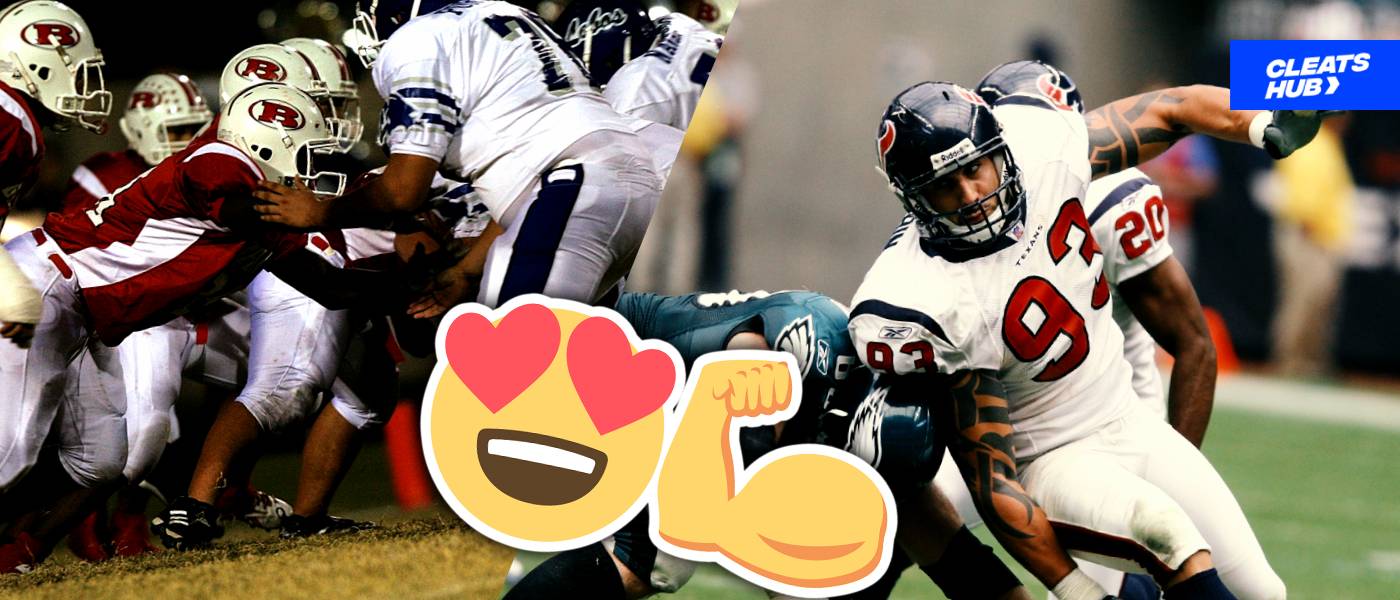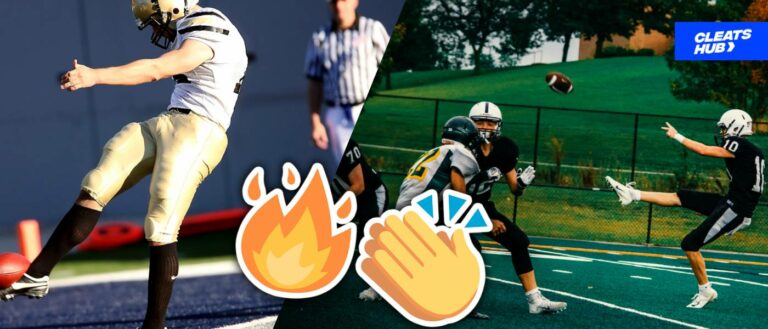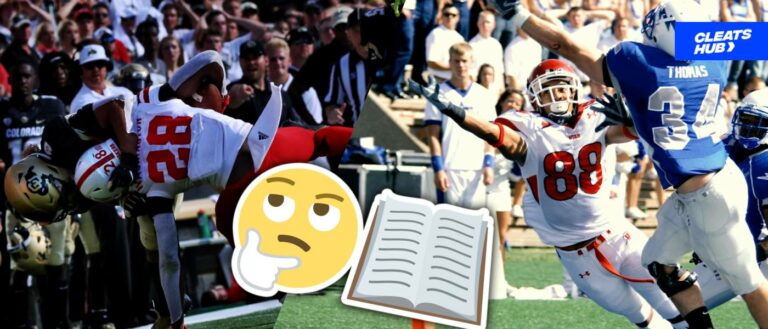What Is The Defensive Line In Football? (About The DL Positions)
Both the offensive and defensive sides of the field in American football need to work together and be in sync. A team’s defense is built around the defensive line, which is made up of strong and quick players.
Here at Cleats Hub, we’ll talk about the defensive line’s purpose and importance, as well as the jobs, methods, and strategies that make it such an important part of a winning team.
About The Defensive Line
The defensive line as a position in football does not refer to a single player but rather a group of players specializing in defensive play. They occupy the line of scrimmage and can be found positioning themselves just opposite the offensive line, ready to halt the offensive play of the opposing team.
The defensive linemen are also referred to as d-linemen or down linemen, and the line is called the “D-Line” for short. Since these players function on the front lines, they can be described as one of the foremost defenses of the team against offensive plays from the opposing team.
In addition, the defensive line’s primary function is sacking quarterbacks when they are on passing plays and also performing blocks and tackles to stop the run from running backs.
How Many Players Make The Defensive Line?
The number of players that make up the defensive line is usually about 3 to 4. This number depends on the defensive formation that is to be adopted by the team.
Generally, the players who take up the positions on the defensive line are the biggest, best-built, and most energetic players on the team. They are also among the highest-paid players on the team.
The Defensive Lineman Position (DL Position)
Football’s defensive lineman position consists of four major roles that are occupied by players. There are:
- Nose Tackle(NT)
- Left Tackle (LT)
- Right Tackle (RT)
- Defensive End (DE)
However, these four positions are grouped into two major positions based on the roles they play in the defensive line. These two positions are:
- Defensive Tackle
- Defensive End
| Major DL Position | Defensive Tackle | Defensive End |
| 1 | Nose Tackle | Defensive End |
| 2 | Right Tackle | – |
| 3 | Left Tackle | – |
About The Defensive Ends
The defensive end is one of the most important players in the defensive line as he has the best shot at tackling the quarterback and stopping a run from the running back.
DEs (as they are sometimes called), are positioned just behind the offensive line, directly facing the offensive line of the opposing team. This open space gives them the chance to maneuver their way into tackling, ensuring the quarterback does not get past them.
Moreover, in instances such as rushing plays, the defensive ends focus more on pushing and funneling the opposing player with the ball towards the center of the field, where there will be more defensemen to tackle him, than on the sidelines.
About The Defensive Tackles
During passing plays, the defensive lineman will try to get into the pocket and tackle the quarterback.
It is typically tough for the tackles to get to the quarterback since they line up in the middle of the formation. In contrast to the defensive end, who works in the open field, defensive tackles are frequently surrounded by bodies.
During passing plays, the defensive tackles are usually overwhelmed by the force of the guard and center lineups of the opposing team. However, during rushing passes, they come in handy.
It is in this scenario that their large build comes in handy, as in rushing passes, the offensive line of the opposing team tries to plunge a hole in the formation for the running back to pass through. But with the large size and build of defensive tackles, they push the defense formation back together.
The Role of the Defensive Line
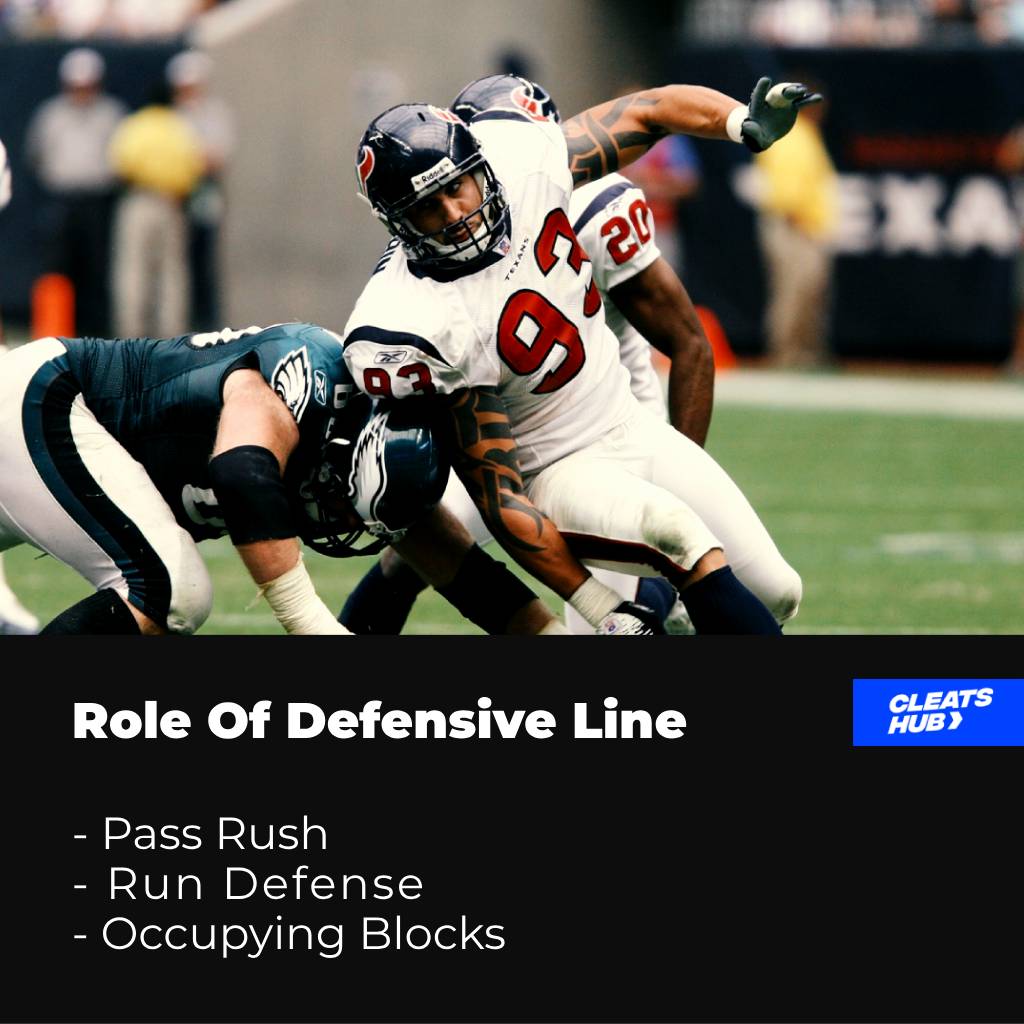
In American football, the defensive line is essential to the team’s defense. Defense ends and defensive tackles make up most of it. Their main goal is to obstruct the offensive plays of the opposition and apply pressure on the quarterback.
The defensive line’s main duties and functions are listed below:
1. Pass Rush
One of the defensive line’s primary responsibilities is to generate a pass rush. Edge rushers, sometimes known as defensive ends, are critical in this regard. They intend to swiftly break through the offensive line and obstruct the quarterback’s throwing game.
Techniques like speed rushes, bull rushes, and spin movements can also be utilized to accomplish this.
2. Run Defense
The defensive line is also in charge of stopping the other team’s rushing attack. Defensive tackles and defensive ends work together to bolster the line of scrimmage and prevent rushing backs from finding opportunities.
They use methods such as gap management, shedding blocks, and tackling to bring down the ball carrier.
3. Occupying Blocks
Defensive linemen routinely interact with offensive linemen to take up their blocks and create opportunities for linebackers to make plays.
Furthermore, defensive linemen can prevent offensive linemen from reaching the second level and blocking linebackers by engaging and tying them up effectively.
Linebackers can now make tackles and thereby interrupt the opponent’s plays.
4. Disrupting Passing Lanes
Even if they don’t sack the quarterback, the defensive line can still make a major effect by impeding throwing lanes.
They may also make it more difficult for the quarterback to locate wide-open receivers, causing him to alter his throwing trajectory.
5. Pursuit and Containment
Defensive linemen must also maintain the spacing they have been assigned and ensure that the ball carrier does not get away from them.
They are also responsible for maintaining play inside the bounds of the field and stopping long runs. This requires a combination of concentration, dexterity, and lateral movement.
Key Positions in the Defensive Line

The defensive line is made up of several roles, each with its own set of duties and skill requirements. Defensive tackles (DTs), defensive ends (DEs), and nose tackles are the three positions (NTs)
Whereas defensive ends line up on the outside corners of the line, defensive tackles line up in the middle, flanking the center or guards.
Because they are often the tallest and strongest players on the line, defensive tackles serve as the interior line’s anchor. They want to stymie the running game by interacting with offensive linemen and wreaking havoc in the backfield.
By escaping offensive tackles with their speed and agility, defensive ends pressure the quarterback while also restricting the edges’ ability to halt outside runs.
Nose tackles typically line up directly opposite the center in a 3-4 defensive configuration. Their major purpose is to keep as many blockers as possible busy so that linebackers may move freely and make plays.
Additionally, they must have tremendous power, leverage, and speed to withstand double teams and maintain control of the line of scrimmage.
Techniques and Skills of the Defensive Line
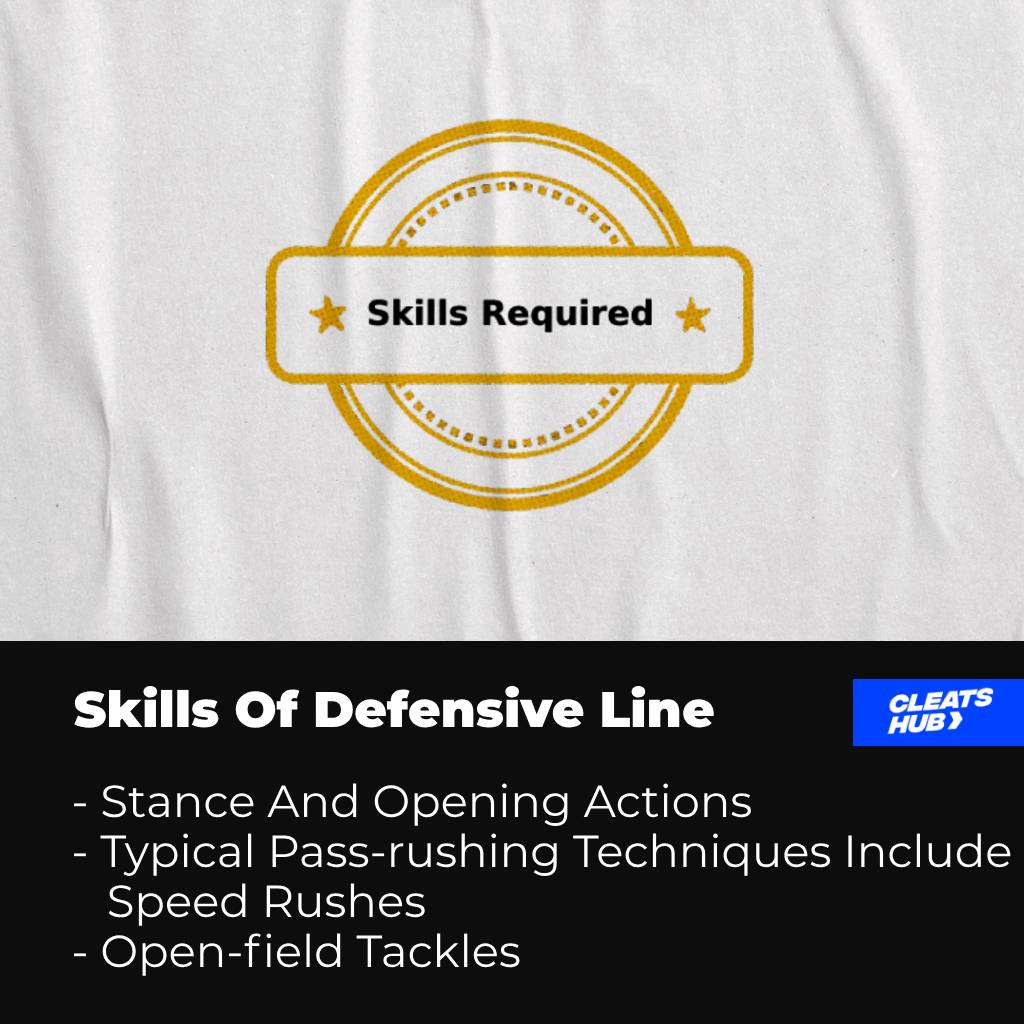
To be effective, a defensive lineman must employ a variety of strategies and abilities. They get a terrific start with their posture and opening moves, allowing them to break away from the line of scrimmage.
Also, blockers must engage and shed in order to disengage and make plays on the ball carrier or quarterback. Gap control and run defense methods such as two-gapping and one-gapping are critical for the offensive to be unable to locate running lanes.
Furthermore, defensive linemen who wish to pass rush must develop a toolbox of strategies for getting past offensive linemen and getting to the quarterback. Speed rushes, in which players utilize their speed to go through offensive tackles, and bull rushes, in which players use their muscles to overwhelm offensive lines, are two common pass-rushing strategies.
It is also possible to fool blockers and create opportunities to interfere with the quarterback by employing tactics like swim, spin, and rip actions.
Additionally, defensive lineman must be able to pursue and tackle their opponents. They must be adept at making open-field tackles and relentless in their pursuit of the ball carrier.
Finally, defensive linemen can change the course of a game by pursuing ball carriers and preventing long gains.
Defensive Line Strategies and Formations

Depending on their defensive plan, the opponent’s tendencies, and the game scenario, teams use a variety of defensive line formations and methods.
- 4-3 Defense:
The traditional 4-3 defense consists of four offensive linemen, two defensive tackles, and two defensive ends. The primary goals of this formation are to maintain gap integrity and provide pressure through the front four. - 3-4 Defense:
Another popular defensive structure is the 3-4 system, which comprises four linebackers and three down linemen. Because linebackers may be employed in a variety of ways, the 3-4 defense is versatile in terms of run defense. - Nickel and Dime:
In passing situations, teams typically deploy nickel and dime packages, replacing defensive linemen with more defensive backs. These alignments provide more pass coverage and allow for a wide range of blitz packages to confuse the quarterback and offensive line.
Defensive Line in Team Defense
To form a cohesive defensive unit, the defensive line must work together with the linebackers and secondary. Communication and pre-snap alterations are vital for ensuring that everyone is ready for the upcoming game.
As the secondary relies on the offensive line to create pressure and obstruct the passing game, the defensive line relies on linebackers to support them and cover any gaps.
The entire defense must work together to ensure proper run fits and gap integrity. To ensure that the offensive is under control, each player has certain jobs and responsibilities.
The defensive line, linebackers, and secondary may all work together to successfully halt the opposing attack.
Notable Defensive Lines in NFL History
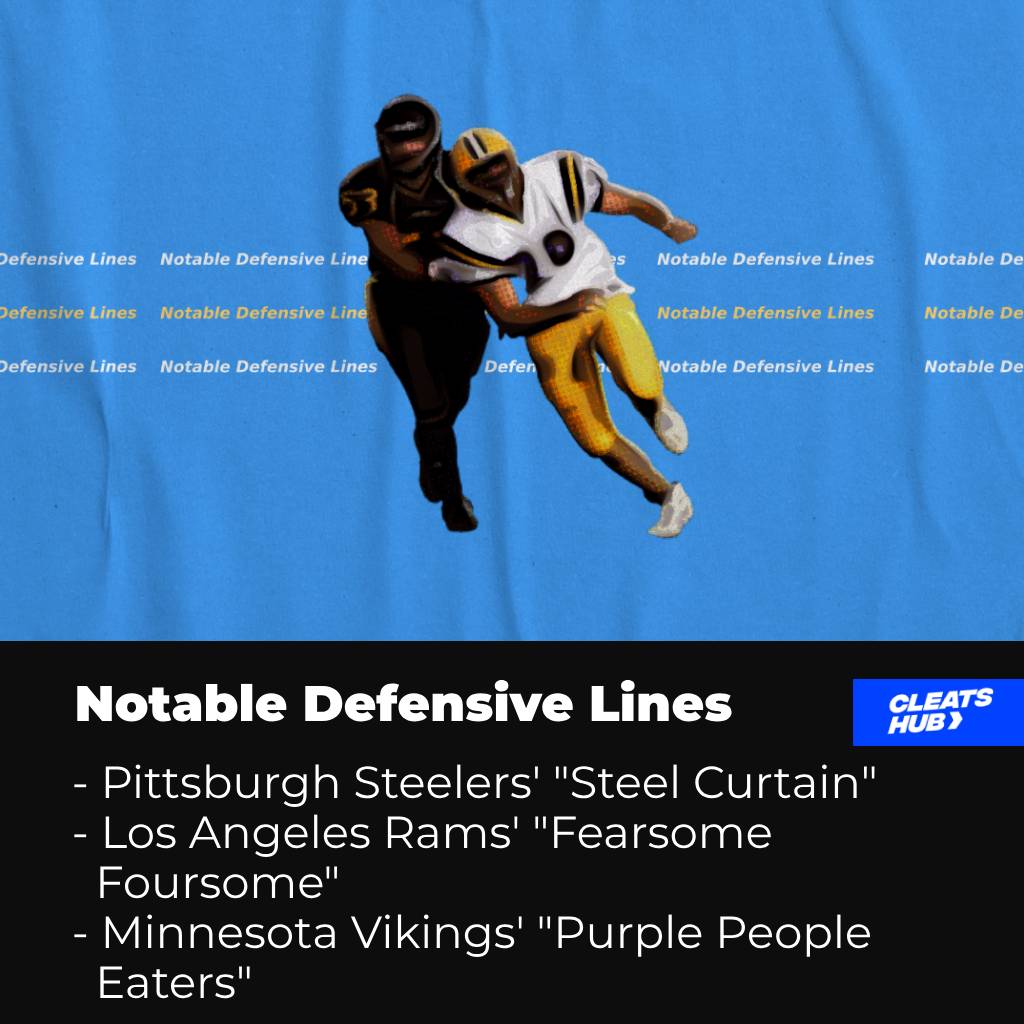
Over the years, the NFL has featured some iconic defensive lines that have forever transformed the game.
In the 1970s, the Pittsburgh Steelers “Steel Curtain”, which included players like Mean Joe Greene and L.C. Greenwood, was famed for its power and helped the team win three Super Bowls.
The Los Angeles Rams “Fearsome Foursome”, which included Deacon Jones and Merlin Olsen, tormented offenses throughout the 1960s and 1970s.
Alan Page and Carl Eller, members of the Minnesota Vikings’ “Purple People Eaters”, had exceptional talent and were critical to the team’s success.
Conclusion
Any effective American football defense must have a strong defensive line. Its players act as the foundation, sabotaging the running game and applying pressure on the quarterback.
Maintaining control of the line of scrimmage and containing the opposing team’s offense depends on the defensive line.
The defensive line continues to play a crucial part as the game develops.

